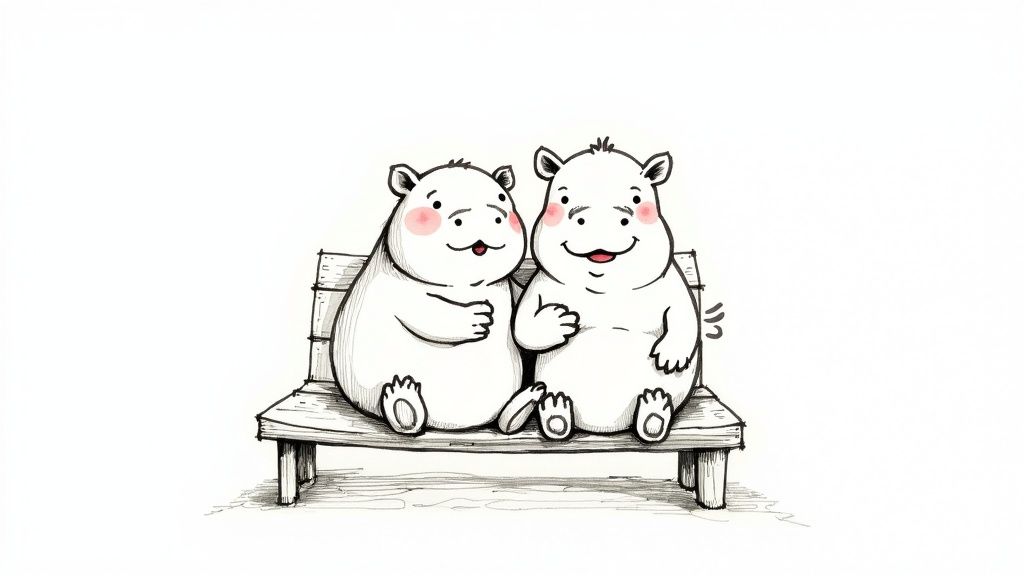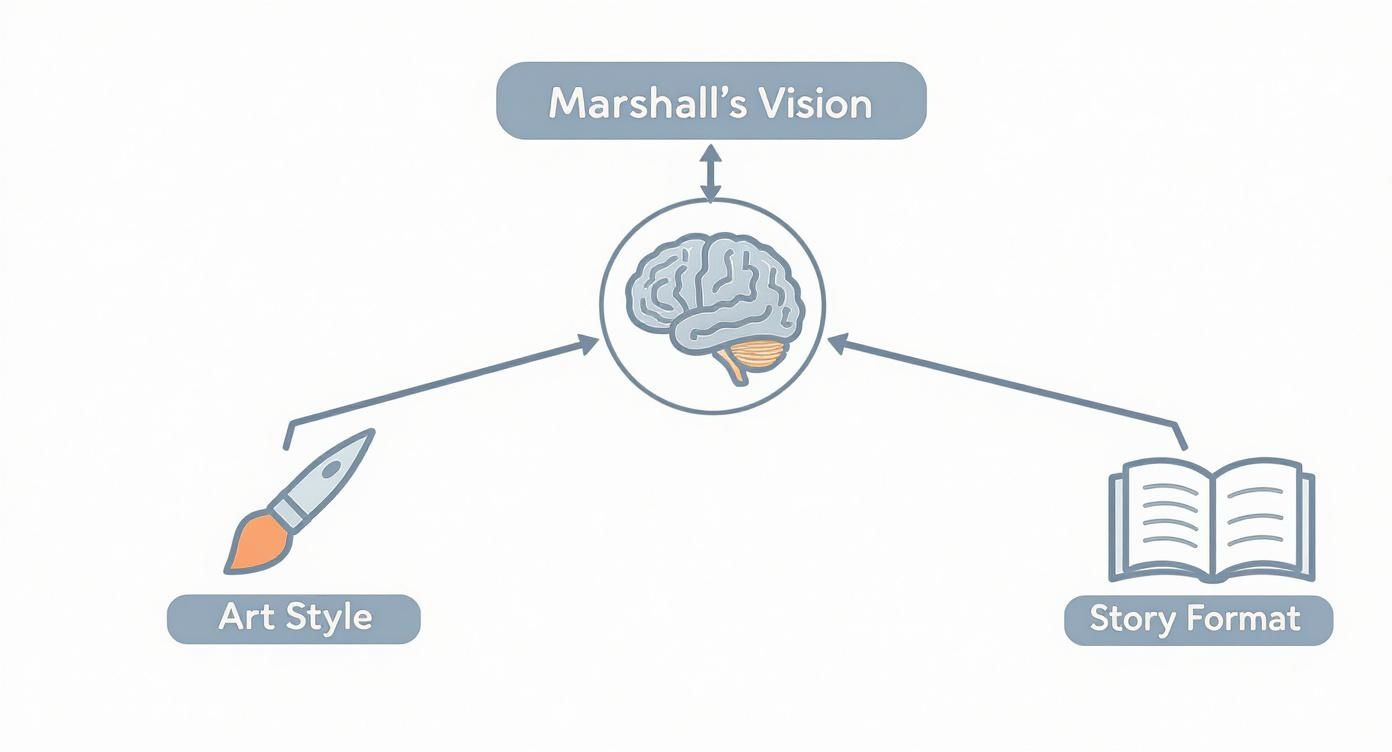If you've ever needed a perfect, gentle introduction to the realities of friendship for a young reader, look no further than James Marshall's George and Martha books. This beloved series features two hippo best friends whose simple stories pack a surprisingly profound punch, exploring the everyday ups and downs of being a good friend with incredible humor and warmth.
Two Hippos and One Great Friendship

Step into the heartwarming, and sometimes hilariously messy, world of two hippos who show us what real friendship is all about. James Marshall's creation is so much more than a simple collection of animal tales; it's a wonderfully insightful look at what it truly means to be there for someone. The series quickly became a staple in children's literature, with over eight books published and more than 1 million copies sold worldwide. You can get more insights on the series' global reach over at kids.kiddle.co.
Through their incredibly relatable struggles—from dealing with a friend's annoying habits to figuring out how to say "I'm sorry"—George and Martha navigate their bond with honesty and genuine affection. Their little adventures provide a brilliant blueprint for understanding the heart of any healthy friendship.
Why Their Stories Endure
The real magic of George and Martha is their authenticity. Marshall didn't create perfect characters, and that's precisely what makes their friendship so powerful and timeless. They show young readers, in the most accessible way, that a strong friendship involves a few key ingredients:
- Honesty: Learning to gently tell the truth, even when it feels a little awkward.
- Empathy: Taking a moment to really try and understand how your friend is feeling.
- Forgiveness: Knowing how to accept an apology and move on from disagreements.
- Respect: Valuing each other’s privacy and giving one another space.
Marshall’s simple stories pack powerful lessons on kindness and compromise, making them a timeless treasure on any bookshelf and an essential tool for social and emotional learning.
The Simple Genius of James Marshall's Storytelling
What is it about two hippo friends that makes their stories so completely unforgettable? The magic of George and Martha comes down to one thing: James Marshall's one-of-a-kind creative vision.
His signature art style is a true masterclass in doing more with less. With just a few perfectly placed lines, he could paint a whole world of emotion. The illustrations aren't just there to look pretty; they're pulling their own weight in the storytelling.
Marshall had a knack for letting his art tell half the story. A simple downturned smile on George’s face or that mischievous glint in Martha’s eye says more than a full page of text ever could. This visual storytelling is the heart of the series' charm, capturing everything from silly, playful moments to the quiet weight of a sincere apology.
A Structure Built for Young Readers
It’s not just the art, though. The very structure of the books is brilliant. Each George and Martha book is broken into five short, self-contained stories. This format is a perfect match for the attention spans of little ones, giving them a complete and satisfying little narrative in just a handful of pages.
This five-story layout lets Marshall explore all the different sides of friendship without ever getting too heavy. Each tiny tale introduces a small, relatable problem and wraps it up with a gentle solution, creating a rhythm that feels both comforting and interesting. The lessons are always there, but they're delivered with such a light touch that they never feel preachy.
The real genius of Marshall's approach was his ability to make big, complex ideas about friendship, honesty, and empathy feel so simple. He trusted his young readers to get the emotion from his art and spare text, which is what makes these stories so accessible and so deeply felt.
The Power of Simplicity
Ultimately, the genius of Marshall’s storytelling is rooted in its simplicity. He just got that the most profound truths about how we relate to each other are often found in the smallest, quietest moments. You won't find grand adventures here. Instead, the books focus on everyday situations that kids can immediately recognize from their own lives.
This focus on the small stuff is what has made the George and Martha series an enduring classic. It respects the intelligence of its audience, all while offering a funny and heartfelt guide to navigating the beautiful, messy reality of friendship. For more insights into creative genius, you can find some fascinating perspectives out there.
Unpacking the Core Lessons of True Friendship
The adventures of George and Martha are so much more than just funny stories about two hippos. If you look a little closer, you'll see they're a masterclass in navigating the tricky, wonderful world of friendship. James Marshall had a real gift for tucking timeless lessons into each simple vignette, making the series an incredible tool for social and emotional learning.
The stories gently walk young readers through the realities of what it means to be a good friend, warts and all.
These lessons aren't preachy or delivered like a lecture. Instead, they unfold through memorable, often hilarious, situations. Just think of Martha’s infamous split pea soup—a dish George secretly can't stand. His quiet struggle between being honest and sparing his friend’s feelings is a perfect, gentle introduction to finding the balance between tact and truthfulness in a relationship.
The Art of Navigating Friendship
Marshall uses these small, everyday conflicts to explore the bigger ideas of how friends should treat one another. He shows us that true friendship isn't about being perfect; it's about handling imperfections with grace and a bit of humor.
A few key lessons are woven throughout the entire series:
- Honesty with Kindness: The books show that while telling the truth is important, how you say it matters just as much. George doesn’t just blurt out that he hates the soup; he finds a way to be honest without being hurtful.
- Respecting Boundaries: In one story, George just wants some privacy, and Martha has to learn to respect his need for personal space. It’s a simple but vital lesson for kids: even the best of friends need time to themselves.
- The Power of Forgiveness: Disagreements are bound to happen, but George and Martha always find their way back to each other. Their ability to forgive and move on shows that one mistake doesn't have to break a strong friendship.
At its heart, the series is a gentle guide to compromise, empathy, and kindness. These funny hippo tales provide the perfect springboard for parents and educators to discuss these important concepts with children in a way they can easily understand.
The table below breaks down some of the most common themes you'll find in the books and which stories are great examples of those lessons.
Key Friendship Lessons in George and Martha Stories
| Friendship Theme | Story Example | Lesson for Readers |
|---|---|---|
| Honesty and Tact | "Split Pea Soup" | It's important to be truthful with friends, but it's just as important to be kind and consider their feelings. |
| Privacy and Space | "The Private Story" | Everyone needs their own space sometimes, and respecting that is a key part of being a good friend. |
| Forgiveness | "The Flying Machine" | Friends make mistakes. True friendship means being able to forgive and move past disagreements. |
| Empathy | "The Mirror" | Trying to understand how your friend feels is crucial, especially when they are feeling down or insecure. |
Each of these stories provides a fantastic opportunity to start a conversation with a child about the ups and downs of their own friendships.

This really highlights how Marshall's minimalist art style and bite-sized story format work together to make complex emotional ideas accessible. His genius was in creating a world where children could learn valuable social skills naturally, just by enjoying a story.
If you're looking to explore more titles with similar themes, check out these excellent books that teach empathy.
A Tour Through the George and Martha Book Collection

There are seven original books in the George and Martha series, so figuring out where to start can feel as tricky as deciding whether to eat a friend’s awful split pea soup. The good news is, each book is made up of five perfectly contained short stories, giving you a wonderful snapshot of the duo’s friendship no matter where you begin.
The whole journey kicked off with the self-titled debut, George and Martha (1972). This is the book that set the tone for everything that followed, introducing us to our hippo friends through charmingly relatable situations. It includes one of the most famous tales, "Split Pea Soup," which brilliantly handles the classic kid dilemma: how do you stay honest without hurting someone's feelings?
Right after that came George and Martha Encore (1973), which deepens their friendship with even more warmth and humor. "The Tub" is a standout story from this one. Martha’s love for privacy teaches George a gentle, funny lesson about personal space—a simple but unforgettable take on mutual respect.
Continuing the Adventures
As the collection grew, it never lost that special something that fans fell in love with. Each new book kept the same charming structure and emotional wisdom.
- George and Martha Rise and Shine (1976): This one features "The Flying Machine," a story where George's big invention doesn't quite take off. It’s a sweet lesson on how to support a friend, even when their plans flop.
- George and Martha, One Fine Day (1978): Here, Marshall starts exploring trickier feelings like jealousy and forgiveness, but always with his signature light touch.
- George and Martha Tons of Fun (1980): This book is exactly what it sounds like—just pure, silly fun that showcases the playful side of their friendship.
Each book serves as a perfect entry point. You can read them in any order without losing the magic, as every story stands on its own while reinforcing the core message of kindness.
Later titles like Back in Town (1984) and Round and Round (1988) gave fans more of the gentle humor and wisdom they'd come to expect from George and Martha. Honestly, no matter which book you grab first, you're in for stories that are both laugh-out-loud funny and genuinely touching.
How George and Martha Leapt from Page to Screen
The delightful friendship between George and Martha was simply too big to stay contained within the pages of a book. Their simple, honest stories were a natural fit for animation. In the late 1990s, the beloved hippos finally made their debut on television, bringing their gentle adventures to a whole new generation.
Translating James Marshall's minimalist art into a full-fledged animated series was no small feat. The challenge was expanding his wonderfully expressive, but sparse, illustrations into a living, breathing world. Animators had to do this without losing the unique charm that made the books so special in the first place. Their focus was on keeping the gentle humor and the core emotional messages, making sure the on-screen duo felt just like the friends readers had known for years.
The result was a show that beautifully captured the spirit of the original stories while giving them new room to breathe in a longer format.
A New Chapter for a Classic Duo
The animated series was a joint Canadian and American production that first aired on April 1, 1999. The show, which ran for 26 episodes, introduced George and Martha to a massive new audience on major networks like HBO Family in the U.S. and YTV in Canada. You can find more details about the production and its broadcast history on Wikipedia.
This transition was a testament to the timeless appeal of their friendship. Even as the series expanded their world, it never strayed from what made the books work: small, relatable problems that get solved with kindness and a good dose of humor. It's a similar path taken by other classic characters, a topic we explore more in this look at the enduring legacy of Curious George.
The show succeeded because it understood the heart of the source material. It wasn't about adding flashy action or complex plots; it was about honoring the quiet, powerful moments of connection between two best friends.
By bringing George and Martha to the screen, the series cemented their place as cultural icons. It proved that a truly great story about friendship can be just as powerful on a television screen as it is on the page of a book.
Bringing Friendship Lessons into the Classroom
The George and Martha books are so much more than just simple stories. They're incredible tools for social and emotional learning that can turn any storytime into a truly meaningful discussion. Their gentle, funny way of exploring big, complicated feelings makes them perfect for the classroom, helping kids learn to navigate the ups and downs of friendship.
Instead of just reading the stories straight through, teachers can use them as a starting point for deeper conversations. By pausing to ask good questions, you can help children see the connections between the hippos' world and their own lives. It builds empathy and self-awareness one story at a time and turns storytime from a passive activity into an active one.
Activities for Specific Stories
Some of the stories are just perfect for lessons on very specific, common childhood challenges. Here are a couple of practical ideas to get you started:
-
Story Focus: "The Mirror"
- Lesson: This story is a fantastic way to open up a conversation about self-image, vanity, and how powerful a genuine compliment can be.
- Activity: After reading, ask students to share one thing they like about themselves. Then, you can encourage them to give a kind, sincere compliment to a classmate, which really helps reinforce positive social skills.
-
Story Focus: "The Secret Club"
- Lesson: This is the perfect tale for exploring feelings like jealousy and exclusion, and for talking about why it’s so important to be inclusive.
- Activity: You could lead a group discussion about what makes a good friend and why it feels bad to be left out. This can even lead to creating a "classroom friendship charter" where the kids all agree on rules to make sure everyone feels welcome.
Thinking about how kids take in these lessons, it's clear how well the books model positive behavior. They offer a safe, observational way for children to understand pro-social social learning concepts.
The real magic of using George and Martha in the classroom is how it opens up a dialogue about big emotions in a small, easy-to-understand way. The stories give students a shared language to talk about feelings they might otherwise have trouble putting into words.
By weaving in activities like these, you help children go beyond just hearing a story and get them to truly understand its message. For more great resources on this topic, you should check out our guide to kids' books on emotions. It offers even more titles to help you build an emotionally intelligent library for your students.
Common Questions About the George and Martha Series
The George and Martha books have been favorites for generations, but their simple charm often brings up a few questions from new parents and teachers. Getting a handle on these details is a great way to understand why James Marshall’s hippo pals have stuck around for so long.
Let's clear up some of the most common points of curiosity.
What Is the Recommended Age Range for the Books
The sweet spot for these stories is typically for kids aged 4 to 8, landing perfectly in that Pre-K to 2nd Grade window. The simple sentences and wonderfully expressive art are a perfect match for little ones just starting their reading journey.
But honestly, the themes are timeless. The dry, clever humor that Marshall slips into every story is something adults can really appreciate, making these books a genuine treat to read together.
Are George and Martha a Couple
This question comes up all the time! The answer is a simple one: George and Martha are best friends. James Marshall was very deliberate in creating their relationship as a purely platonic one, showing a beautiful example of a deep, non-romantic friendship.
Their bond is a powerful model for children, showing that friendship is a profound and complete relationship all on its own. The stories are all about compromise, support, and respecting each other—the bedrock of any great friendship.
How Many Books Are in the Series
James Marshall created seven original books in the official George and Martha series. The full collection includes:
- George and Martha (1972)
- George and Martha Encore (1973)
- George and Martha Rise and Shine (1976)
- George and Martha, One Fine Day (1978)
- George and Martha Tons of Fun (1980)
- George and Martha Back in Town (1984)
- George and Martha Round and Round (1988)
You can also find plenty of treasuries and compilations out there that bundle these short stories into one big volume, making it easy to get the whole collection at once.
At Number 6 Publishing, we believe stories like these are essential for fostering empathy and joy in young readers. Discover more timeless tales and curated reading lists on our website. Find your next family favorite at https://www.number6publishing.com.
